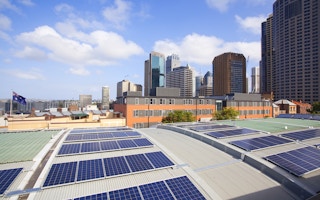A new study has found that Australia could be one of the biggest beneficiaries of a global shift to renewable energy, making huge gains in gross domestic product (GDP), employment, as well as socio-economic and environmental welfare.
To continue reading, subscribe to Eco‑Business.
There's something for everyone. We offer a range of subscription plans.
- Access our stories and receive our Insights Weekly newsletter with the free EB Member plan.
- Unlock unlimited access to our content and archive with EB Circle.
- Publish your content with EB Premium.
If the share of renewables in the global energy mix increases from 18 per cent in 2010 to 36 per cent in 2030, Australia’s corresponding clean energy growth could cause a 1.7 per cent jump in its GDP, said the International Renewable Energy Agency (IRENA), in a report released on Saturday.
Australia’s GDP increase is higher than most other countries, according to IRENA’s Renewable Energy Benefits: Measuring the Economics study, which the United Arab Emirates-based agency says is the first global estimate of the wider economic impacts of a clean energy transition.
The analysis finds that greater renewable energy use will bring socio-economic benefits to almost all countries.
Country-specific projections for renewables growth were obtained using IRENA’s own roadmap to the 2030 target of 36 per cent - known as REmap 2030. A macro-econometric analysis was conducted on these figures to calculate the wider benefits.
The findings showed that doubling the share of renewables worldwide by 2030 could contribute to global GDP growth by US$1.3 trillion, the combined worth of the economies of South Africa, Chile, and Switzerland today. This is a 1.1 per cent increase over business as usual projections.
Greater investment in renewables would account for most of this GDP growth, said the report. The expansion of the clean energy industry would also spur spending in related sectors such as construction, manufacturing, and engineering.
Adnan Amin, IRENA director-general, said in a statement that the report shows that the transition to clean energy “would not only mitigate climate change, but also stimulate the economy, improve human welfare and boost employment worldwide”.
The United States, India, South Africa, and Japan, will also see a big boost to their GDP if IRENA’s renewable energy adoption target is met. Such a scenario would contribute a 3.6 per cent increase to Japan’s GDP, and a 2.4 per cent addition to India’s economy.
However, the report noted that countries like Saudi Arabia and Venezuela, where the oil and gas sector represents 25 per cent of GDP, would see a drop in income, because their economies are not diversified enough to cope with changes in the global energy mix.
Australia, which exports coal, would not be as badly affected, because the coal sector accounts for only eight per cent of its GDP, the report noted.
If global renewable energy doubles by 2030, the renewables industry will also be able to support 24 million jobs worldwide by then, compared to 9.2 million today, said IRENA. The bioenergy, hydropower, and solar sector would account for most of the employment in this sector.
Achieving the needed energy transition would not only mitigate climate change, but also stimulate the economy, improve human welfare and boost employment worldwide.
Adnan Amin, director-general, International Renewable Energy Agency
The biggest winner: Welfare
But the greatest benefit of all could be to human welfare, said IRENA, which measures this using various social, economic, and environmental indicators. These include consumption and investment, spending on health and education, greenhouse gas emissions, and natural resource use.
The impact of renewable energy deployment on welfare is estimated to be three to four times larger than its impact on GDP, with global welfare increasing as much as 3.7 per cent compared to current levels.
For example, reduced air pollution from coal power plants would minimise health problems, while increased GDP and employment would offer more disposable income for people to spend on health and education.
The reduction of greenhouse gas emissions and natural resource use could also lead to decreased economic losses from natural disasters caused by climate change, or conflict over access to scarce resources like water, said IRENA.
“Welfare improvements of course differ by country, but they are overall positive,” said the agency.
Australia, along with India, Indonesia, Japan, and the United States, could see the highest improvements in welfare, primarily thanks to the reduced health impact of air pollution and greenhouse gas emission reductions, showed the report.
The study also found that a shift to renewable power could cut water use by more than a quarter in Australia. This is because solar and wind generation uses up to 200 times less water than natural gas or coal, and is an important development for Australia, which is experiencing a long-term drought in many parts of the country.
Amanda McKenzie, chief executive officer of Australian non-profit Climate Council, noted in a statement that “an economy that is dependent on dirty, ageing and inefficient coal-fired power stations is harmful to our health, our climate and our bottom line”.
“Instead, we can build a stronger, more prosperous society with energy from the wind and the sun, which never runs out and doesn’t drain our water supply like coal,” she said.
IRENA’s Amin added that the study proves that deploying renewable energy and achieving other socio-economic targets are no longer trade-offs.
“Thanks to the growing business case for renewable energy, an investment in one is an investment in both. That is the definition of a win-win scenario,” he said.










